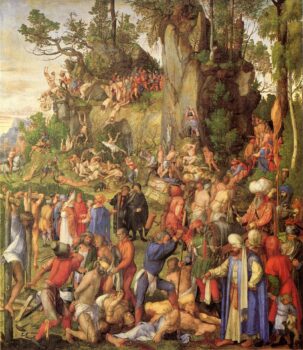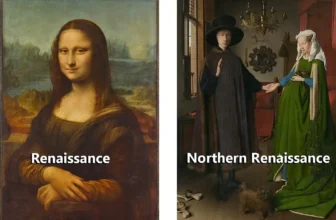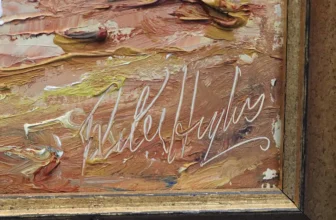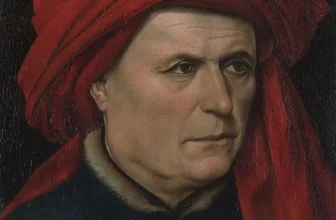Meaning of Albrecht Durer’s The Martyrdom of the Ten Thousand Painting
Albrecht Durer’s The Martyrdom of the Ten Thousand is a profoundly intense and visually complex painting that encapsulates the gruesome suffering of Christian martyrs with powerful symbolism, detail, and artistic mastery. Completed in 1508, this monumental work of art reflects the values and anxieties of its era, merging religious devotion with the stylistic intricacies of the Northern Renaissance. The painting stands as a harrowing depiction of mass martyrdom and a pinnacle of Durer’s career as both a humanist and a devout Christian artist.
Through this 2000-word story post, we will explore the origins, content, and deeper meanings of the painting , including its historical context, the symbolism within, and Durer’s intentions , to offer a holistic understanding of this masterpiece.
What is The Martyrdom of the Ten Thousand All About?
At its core, The Martyrdom of the Ten Thousand depicts the legendary massacre of 10,000 Christian soldiers who were said to have been executed by the Roman Emperor for refusing to renounce their faith. According to legend , which likely evolved through medieval embellishment , these soldiers were subjected to a wide range of tortures and executions in Armenia, all for their Christian beliefs.
Durer’s painting brings this gruesome legend to life on a massive panel filled with violence, anguish, and spiritual transcendence. Unlike many Renaissance paintings that focused on idealized beauty, Durer’s work is unapologetically brutal, portraying countless scenes of torture in one expansive, almost chaotic landscape. Yet beneath the horror lies a complex theological and artistic vision , one meant to glorify the martyrdom of the faithful and evoke contemplation on the nature of suffering, redemption, and the afterlife.
The painting was commissioned by Frederick the Wise, Elector of Saxony, who was a key supporter of the arts and a major figure in the early Protestant Reformation. Durer created the painting in 1508, a time when religious tensions were rising in Europe, and questions about faith, salvation, and the role of the Church were at the forefront of intellectual discourse.
This commission was not Durer’s first engagement with the theme. In fact, he had already explored the subject earlier in a woodcut from 1496, but the 1508 painting was a larger, more detailed, and more ambitious realization. The legend of the Ten Thousand Martyrs was not a canonical biblical story but was nonetheless a popular hagiographic tale in medieval Christianity. It served both as a moral example and as a political statement , reinforcing the idea of Christian virtue in the face of pagan tyranny.
The legend told of Roman soldiers, Christian converts, who were slaughtered on Mount Ararat by order of the Emperor Hadrian or Diocletian, depending on the version. The moral of the story, as seen in the painting, centers on unwavering faith in God, even unto death.
How the Painting Was Made: Techniques and Materials
Durer painted The Martyrdom of the Ten Thousand using oil on a wooden panel, a common medium in the Northern Renaissance. As with much of his mature work, he combined the detailed, textural precision characteristic of Northern European art with Italianate compositional techniques he had studied during his travels to Venice.
At the time, Durer was deeply engaged in merging scientific observation with religious subject matter. His understanding of human anatomy, landscape, and proportion , gleaned from both experience and theoretical study , is evident throughout the piece. Each figure in the chaotic scene is rendered with almost obsessive care, showcasing different methods of execution: crucifixion, flaying, beheading, hanging, burning, and more.
Durer likely used a series of preparatory drawings and studies before committing to the final composition. These preparatory works show the rigor with which he approached storytelling through art, ensuring every gesture and expression supported the overall narrative.
The use of grisaille (a monochromatic painting technique used to imitate sculpture) is absent here, as the full-color oil method enables Durer to heighten the emotional resonance of the work. Blood is red, flesh is pale or contorted, the sky ominously looms , all forming a visceral tableau that draws the viewer into its emotional vortex.
What is Happening in the Painting?
One of the most striking aspects of The Martyrdom of the Ten Thousand is its sprawling, non-linear narrative. Unlike a modern painting with a central focal point, Durer’s composition functions like a tapestry of interconnected episodes. Each cluster of figures within the scene portrays a different form of torture or death.
You see crucifixions on trees and crosses, men thrown from cliffs, individuals flayed alive, and others beaten, stabbed, or decapitated. These horrific scenes are set against a dark forest and mountainous backdrop, suggesting the remote wilderness of Armenia. The entire space is densely populated, offering no respite from the violence. In this sense, the painting overwhelms the viewer , deliberately so , to mirror the overwhelming nature of the martyr’s collective suffering.
At the center-right of the painting stands a calm, almost serene group , Durer’s self-portrait appears here alongside a man in black robes. This insertion of himself into the painting serves as a form of identification with the martyrs, possibly suggesting his solidarity with the faithful or functioning as a memento mori (reminder of death).
In the background, we can spot a hill that may symbolize Golgotha, and the distant cityscape could allude to Jerusalem or perhaps even Nuremberg, blending sacred history with contemporary settings.
Symbolism and Meaning: Layers of Theological Allegory
The painting’s symbolic structure is multi-layered and intentionally dense. The overt symbolism centers on martyrdom and divine reward. Each grotesque act of violence, while horrifying, is meant to serve as a testament to the martyrs’ faith and the promise of eternal life.
Key symbols include:
The Crosses: Referencing Christ’s crucifixion and the emulation of his suffering by the martyrs.
Blood: A recurring visual element, symbolizing not only pain and death but also purification and sacrifice.
Trees: Some martyrs are crucified on trees, possibly evoking the Tree of Life and connecting their death to Christ’s salvific role.
Self-Portrait: Durer’s inclusion in the scene subtly bridges the past and present, drawing the viewer into a contemplative engagement with the theme.
Landscape: The twisted, inhospitable forest may represent spiritual darkness or the world’s cruelty, while the sky hints at divine presence beyond earthly suffering.
Ultimately, the message is one of spiritual triumph. The martyrs may perish in this world, but their faith ensures their place in heaven. This theological message would have resonated deeply in an age when religious persecution and debate were daily realities.
A Fusion of Renaissance Ideals and Northern Detail
The Martyrdom of the Ten Thousand falls within the category of Northern Renaissance religious painting, distinguished by its combination of Gothic intensity and Renaissance humanism. Durer stands at the crossroads of these movements, drawing from Italian developments in anatomy and perspective while retaining the dense detail and spiritual gravitas of Northern art.
The work is also a history painting, depicting a legendary (though non-biblical) event in religious history. Durer’s approach transforms it into a type of visual sermon , didactic, immersive, and emotive.
Additionally, it exhibits characteristics of allegorical painting, using real and imagined elements to convey theological truths, and even proto-expressionism, as the emotions and violence are rendered in such a visceral, dramatic way that it anticipates the expressive movements of later centuries.
Where is The Martyrdom of the Ten Thousand Today?
Today, The Martyrdom of the Ten Thousand is housed in the Kunsthistorisches Museum in Vienna, Austria. The museum is one of the world’s most prestigious art institutions and home to a vast collection of Renaissance and Baroque art.
The painting remains one of Durer’s most important altarpieces, studied by scholars and appreciated by visitors for both its aesthetic qualities and its moral gravity. Despite its grim subject matter, it continues to attract admiration for its technical brilliance, narrative depth, and emotional force.
Durer’s The Martyrdom of the Ten Thousand was influential in shaping how later generations of artists approached religious suffering. Unlike Italian idealism, Durer’s realism emphasized the human cost of spiritual faith. His art speaks to both the horror of persecution and the dignity of belief.
As Protestant Reformation ideals began to reshape the religious landscape of Europe, Durer’s painting stood at a pivotal moment , reflecting both the continuity of Christian martyr traditions and the urgency of moral conviction in a time of change.
Moreover, his decision to portray such disturbing content with unsparing clarity paved the way for Baroque artists like Caravaggio and Rembrandt, who would also explore themes of suffering and divine grace in the human condition.
A Masterpiece of Devotion and Discomfort
The Martyrdom of the Ten Thousand is not an easy painting to look at. Its violence is raw, its composition overwhelming, its message unsettling. And yet, it is precisely this emotional intensity that makes it one of the most powerful works of the German Renaissance.
Albrecht Durer used his unmatched skill not merely to depict death, but to affirm life , spiritual, eternal life , for those who endure suffering with faith. In doing so, he left behind a timeless meditation on the cost of conviction and the hope that lies beyond pain.
Today, over five centuries later, Durer’s masterpiece continues to challenge, provoke, and inspire , a testament to both artistic genius and human resilience.




